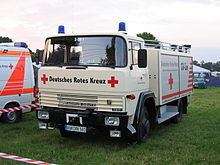Medical service (disaster control)

The medical service (SanDi or SanD) is a specialist civil protection service in Germany. Its task is to care for the injured and sick in the event of a mass casualty or major damage or disaster. Above all, this includes the creation of the necessary infrastructure by setting up treatment stations and setting up rescue equipment holding areas. The units of the medical service consist of volunteer workers who complete appropriate specialist training for their work.
Tasks of the medical service
In disaster control, the medical service has the task of looking after those people who have been injured or sick as a result of a major loss event or a dangerous situation. Those uninjured, however, are taken over by the care service. The medical service works closely with the rescue service . His tasks include:
- Bringing urgently needed material such as stretchers, blankets, infusions, oxygen devices, bandages, etc. in the required quantity to the deployment site
- Creation of the necessary infrastructures at the place of use by setting up a treatment center
- Search of the injured
- First aid for the injured
- Assumption of injured persons first treated by other helpers and transport to the treatment center
- Establishing and maintaining the ability to transport the injured
- Care and support for the injured and sick up to their removal to the clinic
- Transport of the injured and sick to the clinic
- Taking over the medical care of contaminated injured persons
- Implementation of makeshift decontamination
- Implementation of the registration and documentation
Nowadays, these tasks are often ensured by setting up and operating a treatment center.
Medical service units
For logistical and tactical reasons, the medical service is organized in so-called units with a fixed number of helpers with appropriate equipment. Helpers with appropriate additional training take over the management of these units or their sub-units. Like the other disaster control units, the medical service units are staffed by volunteers and are provided on site by the following organizations in particular:
- Workers Samaritan Association
- German Life Saving Society
- German Red Cross
- Johanniter Accident Aid
- Maltese relief service
The material and financial resources are provided by the federal government (for the area of civil protection ), the federal states (disaster control authorities), the districts or urban districts and, if necessary, by the organizations themselves. In the event of an emergency, the units of the medical service are subordinate to the responsible lower disaster control authority. Depending on the equipment, the alarm is triggered on site by radio signal receivers or normal telephone equipment . As a rule, the medical service is represented in all federal states per district or urban district with at least one unit in train strength. The exception here is Rhineland-Palatinate, which only prescribes one rapid response group per district or urban district.
- Rapid response group (SEG)
Compared to the regular disaster control units, rapid response groups have a significantly shorter lead time from the alarm to arrival at the scene, usually 30 minutes for a rapid response group compared to one to two hours for disaster control units (depending on the concept / specifications of the respective federal state). Rapid response groups with a focus on the medical service have existed for some time and at many locations in Germany. A rapid action group has i. d. Usually a strength of six to fifteen helpers. In some places the term “special task force” was used instead of “Schnell-”.

- Ambulance train
In the past: The medical train was formerly the standard unit of the medical service and was standardized nationwide according to the strength and equipment verification (STAN) 041. He had a strength of 3/12/35/50 . A medical train was divided into a platoon as a command unit, a group of doctors , three medical groups and a transport group for the injured. There were two smaller variants of the standard medical train: the medical train-T with a focus on transport (formerly ambulance train) and a strength of 1/7/20/28 and the medical train-A with a focus on medical care (formerly first aid train) and a strength of 3 / 7/18/28 . The command unit consisted of a Zugtruppkraftwagen (ZTrKW) and a motorbike. In the medical group came two doctor squad vehicles (KrLKW; together with group leaders) (ArztTrKW) and an ambulance lorries for transportation of the forces and of the material used. In the medical group, station wagons ( medical group vehicles ) were used to transport the emergency services. The injured transport group had four (only one in the case of the A -ambulance ) 4-stretcher ambulances .
Nowadays: According to the law on the reorganization of civil protection (ZSNeuOG), this concept for a medical train is no longer defined by the federal government. Today disaster control is the task of the federal states. In some cases, there are country-specific concepts for corresponding disaster control units. Newer vehicles such as medical equipment trolleys or emergency ambulances are also used here. The question of the existence of medical trains, their strength and equipment therefore depends on the respective state law.
In Hessen z. B. the "KatSDV 400 HE, the medical train in the disaster control of the state of Hesse" decisive. A medical train in Hessen consists of three sub-units:
- Train squad with a ELW 1 or KdoW ( thickness : 1/1/2/ 4 )
- SEG treatment with a GW-San ( thickness : 2/4/ 6 ) and a RTW or KTW B ( thickness : 3/ 3 )
- Transport group having two KTW B ( thickness : 1/2/ 3 and 3/ 3 ), a RTW or KTW B ( thickness : 3/ 3 ) and a RTW or KTW ( thickness : 3/ 3 )
Altogether there are 7 vehicles with a strength of 1/4/20/25 people.
- Insert unit
The emergency unit designed as a replacement for the medical and care trains (also called the emergency train in some countries) combines the two specialist services, medical and care services, in a multifunctional unit with appropriate training for the helpers. Depending on the state, the task force has 30 to 33 helpers. The medical service is set up in the form of a medical group within the operational unit. Often, a mission unit includes (at least) one doctor. However, the concept of the unit is not used in all federal states and is not available in every aid organization.
- DRK relief train
The DRK relief train existed from 1953 to 2007 and was the only supra-regional civil protection and disaster control unit . For the medical and nursing care of those affected, an ambulance and care group as well as a medical group were part of the rescue train. The capacity of the emergency train in the care area was 30 beds per emergency train department. In addition to being used in the event of a disaster, this also represented a fall-back level in the event of disruptions in the system of daily nursing services.
Despite the official dissolution of the DRK relief train, some DRK regional associations stuck to the concept of a supraregional deployment component. For example, the DRK regional association of Hesse renamed the former "Auxiliary Train Department V - Fritzlar (LV Hessen)" to "DRK regional reinforcement Hesse" after the dissolution and has maintained this unit to this day.
literature
- Udo Helms (edit.), German Red Cross (ed.): Manual for the medical service. 2nd Edition. Self-published by the DRK, Bonn 1994, ISBN 3-98-029474-9 .
- G. Zerlett (Hrsg.): Handbook Sanitätsdienst: First Aid - Rescue - Disaster Control. Ecomed Fachverlag, Landsberg / Lech 1999, ISBN 3-60-970630-9 (loose-leaf collection with supplementary supplies ).
- Hanno Peter, Johann W. Weidringer: The treatment center. Stumpf & Kossendey, Edewecht and Vienna 2001, ISBN 3-93-275058-6 .
- Jürgen Schreiber: MANV with dangerous substances and goods (GSG). Stumpf & Kossendey, Edewecht and Vienna 2003, ISBN 3-93-275085-3 .
- Egon Jung: Textbook for the medical service. Hofmann, Hildburghausen 2004, ISBN 3-92-286565-8 .
Individual evidence
- ↑ a b c d e f g h i BBK / BZS: Sanitätsdienst (SanDi) in disaster control. Medical train strength and equipment verification (SZ). STAN no. 041. As of May 1984.
- ↑ see also: Evidence of strength and equipment (STAN) for the units and facilities of disaster control .
- ↑ [1]
- ↑ Hessian Ministry of the Interior and for Sport: KatSDV 400 HE - The medical train in disaster control in Hesse. In: www.innen.hessen.de. Hessian Ministry of the Interior and for Sport, April 1, 2012, accessed on August 15, 2019 .
- ^ DRK state association Hessen eV: DRK state reinforcement Hessen. August 8, 2019, accessed August 15, 2019 .
